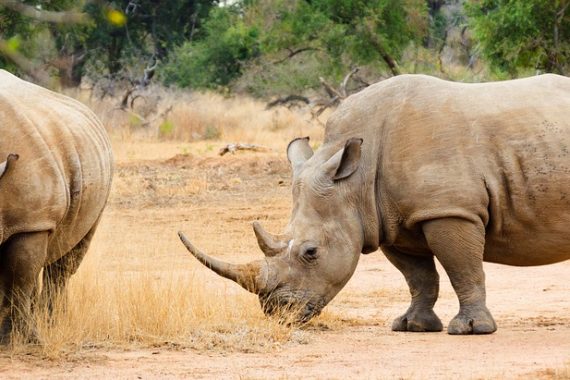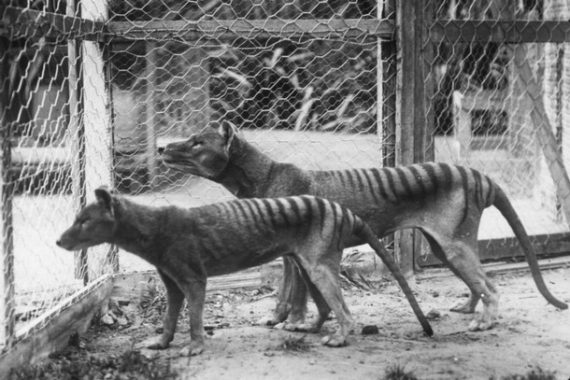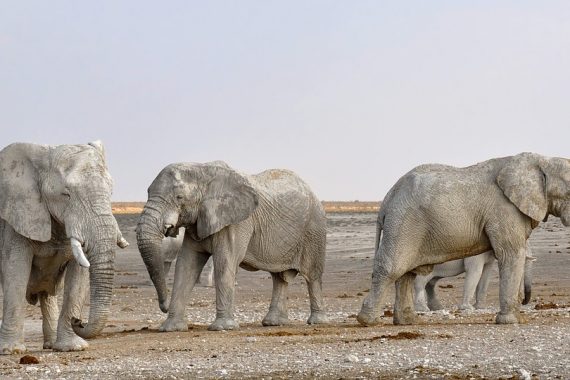Crafty crows: the canniest corvids!
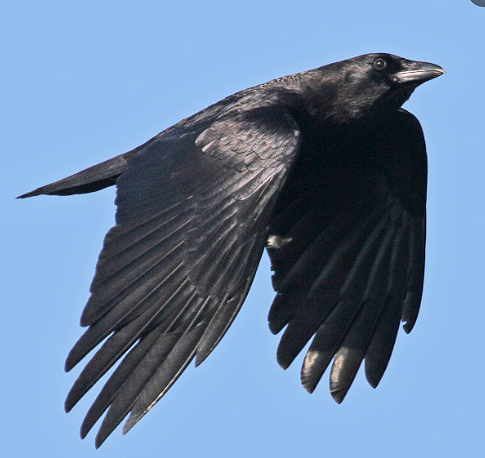
The American Crow in flight (image from https://ebird.org/species/amecro)
Crows are a member of the clever corvid family, containing a diverse array of species including ravens, choughs, jays and magpies. The 45 members of the Corvus genus occur all over the world except for South America and a few islands. The ancient ancestors of crows are believed to have evolved in Central Asia and moved outwards to colonise North America, Africa, Europe, and Australia.
They are omnivorous and not particularly fussy about what they eat, taking trash, berries, small animals, the eggs of other birds and even have been known to attack and kill weak farm animals, making them particularly unpopular with the unfortunate farmer.
Crows are also cooperative breeders, meaning that large groups nest close together and look after their young.
Although crows are ubiquitous and a common sight for even the least interested wildlife watcher, not all are so abundant; the Hawaiian crow is one of the rarest birds of earth, and the Flores crow is listed as endangered by the IUCN.
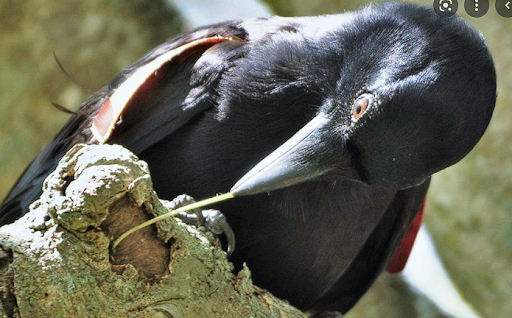
A clever New Caledonian Crow using a branch shaped into a hook to extract tasty grubs from a tree hollow. Image from https://www.bbc.co.uk/news/science-environment-37024393
Not so bird brained?: the incredible cleverness of crows!
For a long time, behavioural scientists neglected studying much of the animal kingdom’s intelligence in favour of primates with their human like mannerisms. Despite long standing anecdotal records of crow intelligence, it wasn’t until the 90’s and early 2000s that studies were published on New Caledonian crows shaping and using hooks to extract grubs from crevices. The wealth of studies conducted since has found incredibly crafty behaviour;
- Tool use and manufacture: as well shaping twigs and pieces of metal into hooks, crows have been recorded shaping leaves into picks to spear insect prey. In laboratory tests, a famous research crow, Betty, was able to use unnatural material like metal piping to fashion into hooks of different shapes depending on the shape and size of the tube in which her food treat was hidden. She could also select the correct tool from a box to retrieve food. Crows have even been shown to preferentially make different tools in different parts of the world; some scientists have related this to how chimpanzees use different tools in different communities. This is often viewed as culture, something once believed to the province of humans only.
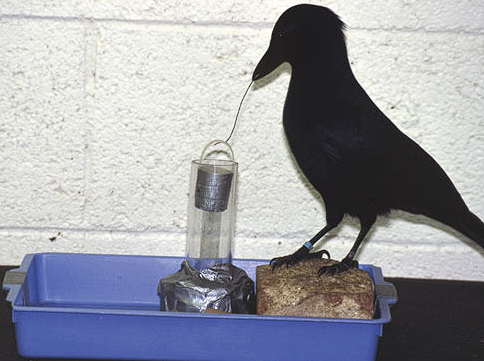
Image from https://www.bbc.co.uk/news/science-environment-37024393
- Understanding time: Crows have shown understanding of time and space through their caching behaviour. Many animals hide food for later, but this is shown to be more complex in crows, who display understanding of the perishability of food and therefore where it should be stored. Laboratory studies with the Florida Scrub Jay have shown that they will preferentially cache perishable foods but won’t return to them once they know they have rotted; they will only return to their non-perishable caches.
- Social awareness: on the subject of caching, crows have also shown an awareness of the behaviour of other crows and how this may affect them. Crows have shown awareness of being watched by other crows when caching their tasty treats; they will hide food behind barriers or wait for other individuals to be distracted before continuing storing their dinner. Crows have even been seen trying to mislead researchers; when the field biologists were present, crows would tend to a fake nest, only to return to their real nest as soon as they were no longer being watched!
- Understanding of the world around them: in Queensland, which is currently being overrun with poisonous cane toads, the crows have learnt to flip the toads onto their back and stab them in their throat; this allows them to get to the tasty, non-toxic insides of the unfortunate toad, as their skin is much thinner at the throat. In Japan, crows use drinking fountains not just for the hydration, they also adjust the flow of water accordingly using the taps so they can have a refreshing bath.
- Relationships with other animals: corvids have been known to hang around with wolf packs, especially in the harsh winter, to get a share of their hunt. The birds will locate an injured elk or deer and call the wolf pack to the location, waiting around for the chance to grab a chunk from the kill. They are even known to differentiate between coyotes and wolves, preferring to become temporary members of the wolf pack, likely because wolves kill larger prey. Larger prey means a bigger dinner for the canny corvid! They have even been seen playing with the cubs in Yellowstone National Park by chasing them and poking at their tails.
Their intelligence can be seen simply by looking at the structure of their brains. Although the brain looks very different in crows and humans, crows possess particularly large forebrains, which is associated with social skills, planning, learning and decision making in humans and primates. When scientists first looked at the anatomy of bird brains, they were surprised to find that birds do not have layered cerebral cortexes, the integration centre of the primate brain and vital in higher intelligence. Instead of these layers, corvid brains have nuclear organised circuits that provide up to double the number of neurons found in a primate brain of the same size! Perhaps we need to re-think the insult bird brained?
Aside from some species of parrot, corvids have the largest brains of any birds, which is a reliable way of determining species intelligence.
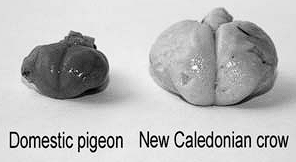
Comparing the brains of the not so bright pigeon and the much smarter New Caledonian crow. Brain size to body size ratio is often a reliable indicator of species intelligence. Image from https://users.ox.ac.uk/~kgroup/tools/neurobiology.shtml
Unfortunately, this intelligence means crows and humans often bump heads. They are incredibly adaptable and opportunistic, often damaging property and stealing crops and in many parts of the world they are considered pests.
Corvids in crisis: endangered crows
Although very common across the world, they are some species of crow in trouble. The forefront of these is the Hawaiian crow or ‘Alalā (Corvus hawaiiensis) which has recently been reintroduced into the wild after going extinct. As is common for island species like the Hawaiian crow, they are more specialised than their mainland counterparts and evolved to feed on understory fruits and seeds specifically. Their limited distribution and specialised feeding put these crows at risk when logging, agricultural intensification, loss of pollinators and invasive species began to put pressure on the island. Introduced cats carried dangerous parasitic diseases to the population, and feral pig hunters would often shoot the birds to stop them alarm calling and scaring away their quarry. Fortunately, in the late nineties, conservationists realised the dire situation after the last known wild egg was laid and a captive breeding programme was started with 90 birds. In recent years, increasing numbers of birds have been released, bringing back an essential part of the ecosystem.
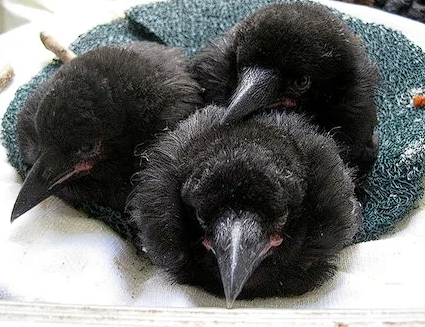
Hawaiian crow fledglings in the Hawaiian Endangered Bird Sanctuary. (Image from www.hawaiimagazine.com)
The Flores Crow (Corvus florensis) is a smaller crow confined to the small island of Flores in Indonesia. The small population surviving here is facing imminent extinction from the massive deforestation the island is experiencing. Unfortunately, Flores is not always considered a conservation hotspot, and so the future of the crow is unsure.
The corvid research blog is a great website that contains all the most recent updates from the ever-expanding field of corvid research. Check it out at:
Videos of the week!
Learn about the intelligence of crows with this quick video rundown of studies into crow cognition.
See how crows problem solve with this video from the BBC Earth documentary Inside the Animal Mind.
References
Barker, F.K. Cibois, A. Schikler, P. Feinstein, J. and Carcraft, J. (2004) ‘Phylogeny and diversification of the largest avian radiation.’ PNAS, 101(30), pp 11040-11045
Emery, N.J. and Clayton, N.S. (2004) ‘The mentality of crows: convergent evolution of intelligence in corvids and apes.’ Science, 306(57043), pp 1903-1907
Greggor, A.L. Masuda, B. Gaudioso-Levita, J.M. Nelson, J.T. White, T.H. Shier, D.M. Farabaugh, S.M. and Swaisgood, R.R. (2021) ‘Pre-release training, predator interactions and evidence for persistence of anti-predator behaviour in reintroduced Hawaiian crow.’ Global Ecology and Conservation, 28
Higuchi, H (2021) ‘Carrion crow manipulating water taps from drinking and bathing.’ British Birds, 112, pp 167-169
https://www.australiangeographic.com.au/topics/wildlife/2018/01/can-crows-eat-cane-toads/
https://corvidresearch.blog/tag/endangered-crow/
http://datazone.birdlife.org/species/factsheet/22705956
https://www.rspb.org.uk/birds-and-wildlife/wildlife-guides/bird-a-z/crow-family/
Hunt, G.R. (1996) ‘Manufacture and use of hook tools by New Caledonian crows.’ Nature, 379, pp 249-251
Naturalist Notes: Wolves and Ravens, March 2020
Nieder, A. (2017) ‘Inside the corvid brain- probing the physiology of cognition in crows.’ Current Opinion in Behavioural Sciences, 16, pp 8-14


